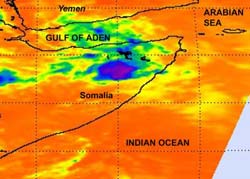Bandu begone: Tropical Cyclone 2A fading in Somalia

On May 22 at 22:29 UTC (6:29 p.m. EDT) NASA\'s Atmospheric Infrared Sounder flying aboard the NASA Aqua satellite captured a small area of cold clouds (blue) associated the remnants of Bandu. Credit: NASA JPL, Ed Olsen<br>
Before 24 hours had elapsed, Bandu had already dissipated because of cooler waters, higher wind shear and drier air in the Gulf of Aden. It curved southwest and made landfall in northeast Somalia. On May 22 at 22:29 UTC (6:29 p.m. EDT) NASA's Atmospheric Infrared Sounder (AIRS) flying aboard the NASA Aqua satellite captured a small area of cold clouds associated the remnants of Bandu. AIRS measures cloud-top temperatures and noticed the remnants over the Sool and Puntland regions of Somalia.
On Monday, May 24, the remnants of Bandu were still bringing showers to northeastern Somalia. Forecasts for the cities of Garowe and Las Anod call for widely scattered showers and thunderstorms with temperatures in the low 80s (Fahrenheit) as Bandu's remnants continue to dissipate. Garowe is the capital city of the Puntland administrative region of Somalia. Las Anod is the administrative capital of Sool region of Somalia.
Media Contact
More Information:
http://www.nasa.govAll latest news from the category: Earth Sciences
Earth Sciences (also referred to as Geosciences), which deals with basic issues surrounding our planet, plays a vital role in the area of energy and raw materials supply.
Earth Sciences comprises subjects such as geology, geography, geological informatics, paleontology, mineralogy, petrography, crystallography, geophysics, geodesy, glaciology, cartography, photogrammetry, meteorology and seismology, early-warning systems, earthquake research and polar research.
Newest articles

A universal framework for spatial biology
SpatialData is a freely accessible tool to unify and integrate data from different omics technologies accounting for spatial information, which can provide holistic insights into health and disease. Biological processes…

How complex biological processes arise
A $20 million grant from the U.S. National Science Foundation (NSF) will support the establishment and operation of the National Synthesis Center for Emergence in the Molecular and Cellular Sciences (NCEMS) at…

Airborne single-photon lidar system achieves high-resolution 3D imaging
Compact, low-power system opens doors for photon-efficient drone and satellite-based environmental monitoring and mapping. Researchers have developed a compact and lightweight single-photon airborne lidar system that can acquire high-resolution 3D…





















